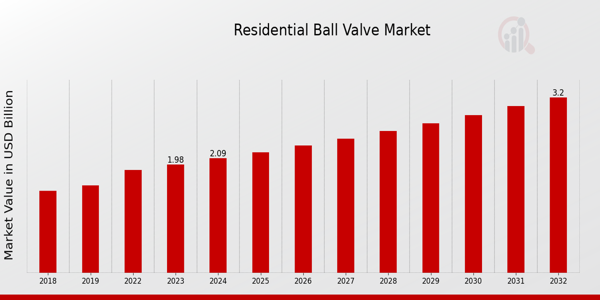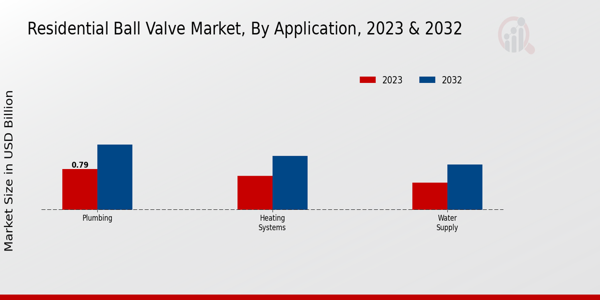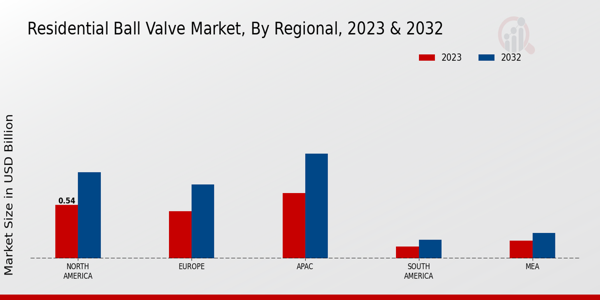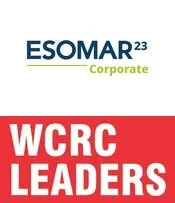Global Residential Ball Valve Market Overview:
As per MRFR analysis, the Residential Ball Valve Market Size was estimated at 2.21 (USD Billion) in 2024. The Residential Ball Valve Market Industry is expected to grow from 2.33 (USD Billion) in 2025 to 3.76 (USD Billion) till 2034, at a CAGR (growth rate) is expected to be around 5.48% during the forecast period (2025 - 2034).
Key Residential Ball Valve Market Trends Highlighted
The Residential Ball Valve Market is influenced by several key market drivers. Growing demand for efficient water management systems, coupled with the increasing focus on energy conservation, is propelling the adoption of ball valves in residential applications. Moreover, the rising awareness of water conservation techniques among homeowners aligns with governmental regulations promoting efficient resource usage.
The trend of smart home technology integration, which often includes automated valve systems, further boosts the market. Manufacturers are increasingly innovating to meet the needs of eco-conscious consumers, which shapes product development. Opportunities in this market primarily revolve around the advancement of technology and the increasing demand for automation in residential settings. As smart homes become more prevalent, there is a rising demand for automated ball valves that can be integrated with home automation systems. This trend not only offers convenience but also enhances efficiency, allowing homeowners to monitor and control their water supply with ease. Additionally, the expansion of green building projects presents another avenue for growth, where sustainability practices drive the adoption of energy-efficient valve solutions.
Trends in recent times indicate a shift toward higher-quality materials and environmentally friendly production processes. Market players are focusing on durable materials that offer longevity and better performance under various conditions. The growing influence of online sales channels is also reshaping how ball valves are marketed and sold, making products more accessible to consumers. Furthermore, the customization of valve solutions is gaining traction as homeowners seek tailored products to fit specific needs. Overall, the landscape of the Residential Ball Valve Market is evolving, driven by new technologies, increased demand for sustainability, and adaptation to changing consumer preferences.

Source: Primary Research, Secondary Research, MRFR Database and Analyst Review
Residential Ball Valve Market Drivers
Increasing Demand for Efficient Plumbing Solutions
The Residential Ball Valve Market Industry is experiencing significant growth due to the increasing demand for efficient and reliable plumbing solutions in residential buildings. As homeowners seek to improve their water management systems, the demand for high-quality ball valves is rising sharply. Ball valves are favored for their durability, excellent sealing properties, and ease of use, which makes them a preferred choice in plumbing applications. Additionally, with the growing trend toward smart homes and automated systems, the integration of advanced plumbing solutions is creating a substantial market for ball valves.
The emphasis on water conservation and the need for efficient water control systems are further propelling the adoption of residential ball valves. As regulations regarding plumbing standards become more stringent, manufacturers are looking to innovate and provide better solutions that not only comply with these regulations but also offer extended service life and reduced maintenance costs, thus enhancing their appeal in the Residential Ball Valve Market Industry. This increasing trend toward modernization and efficiency in domestic plumbing systems signifies a promising growth trajectory for the ball valve market in the foreseeable future.
Technological Advancements in Valve Manufacturing
Technological advancements in valve manufacturing processes are significantly driving growth in the Residential Ball Valve Market Industry. Innovations such as computer-aided design (CAD), automated production techniques, and advanced materials are improving the quality and reliability of ball valves. These advancements allow manufacturers to produce high-performance valves that better meet the needs of residential applications. With improved manufacturing technologies, companies can produce lightweight, corrosion-resistant, and more durable ball valves, catering to the evolving preferences of consumers.
The trend towards incorporating smart technologies into ball valves is also gaining traction, further enhancing their functionality. This progress in manufacturing technology is expected to sustain the competitive edge of the Residential Ball Valve Market Industry and fuel growth in the coming years.
Growing Construction and Infrastructure Development
The growth of construction and infrastructure development globally is a key driver of the Residential Ball Valve Market Industry. As new residential buildings are constructed and existing ones are renovated, the demand for reliable plumbing systems, including ball valves, is increasing. This surge in construction activities, particularly in emerging economies, is creating a robust market for ball valves to be used in various applications ranging from water supply systems to heating setups.
Furthermore, the government's initiatives aimed at promoting residential development and infrastructure upgrades are incentivizing builders and contractors to invest in high-quality plumbing solutions, driving the expansion of the ball valve market. The increasing focus on eco-friendly building practices also encourages the adoption of efficient water management solutions, further bolstering the demand for ball valves.
Residential Ball Valve Market Segment Insights:
Residential Ball Valve Market Application Insights
The Residential Ball Valve Market, valued at 1.98 USD Billion in 2023, showcases substantial segmentation within its application, highlighting Plumbing, Heating Systems, and Water Supply as key areas. Plumbing holds a majority share in this segment, with a valuation of 0.79 USD Billion in 2023, projected to grow to 1.27 USD Billion by 2032. This dominance can be attributed to the ongoing demand for efficient plumbing fixtures and renovations in residential buildings, where ball valves provide crucial control over water flow. Following closely, the Heating Systems application is valued at 0.66 USD Billion in 2023 and is expected to reach 1.05 USD Billion by 2032, reflecting significant growth due to the increasing need for effective temperature regulation in homes, which benefits from the reliability and performance of ball valves.
Additionally, the Water Supply application, while comparatively smaller, is valued at 0.53 USD Billion in 2023, growing to 0.88 USD Billion by 2032. This segment remains vital, as ball valves are essential in maintaining water quality and safety in residential supply systems. The overall growth in the Residential Ball Valve Market can be attributed to urbanization, increasing standards for home construction, and a rise in awareness of energy-efficient systems. However, challenges such as fluctuating raw material costs and strict regulatory standards may pose hurdles for market participants.
Notably, opportunities abound in technological advancements and innovative valve designs, promising enhanced functionality and environmental sustainability within the market, further strengthening its landscape and confidence in the future of applications like Plumbing, Heating Systems, and Water Supply. As the market evolves, the mixing of high-demand applications and their respective valuations showcases how the Residential Ball Valve Market continues to adapt to consumer needs and industry trends, reinforcing its relevance in modern residential infrastructure.

Source: Primary Research, Secondary Research, MRFR Database and Analyst Review
Residential Ball Valve Market Material Insights
The Residential Ball Valve Market, valued at 1.98 billion USD in 2023, showcases a diverse and dynamic material segment, which includes Brass, Stainless Steel, PVC, and Bronze. As the market evolves, Brass dominates due to its excellent corrosion resistance and strength, making it a preferred choice for many applications. Stainless Steel is also significant, known for its durability and aesthetic appeal, which is increasingly favored in modern residential designs. PVC has gained traction owing to its lightweight nature, cost-effectiveness, and resistance to chemical damage, positioning it as a valuable alternative in certain environments.
Meanwhile, Bronze remains important for its robust properties and reliability in high-pressure applications. The Residential Ball Valve Market segmentation highlights how materials drive functionality and performance, and their unique characteristics cater to various consumer needs and preferences, reflecting broader trends in sustainability and efficiency within the industry. The market is further supported by growth drivers such as increasing residential construction and renovation projects, generating ample opportunities for these materials.
Understanding these dynamics is crucial for stakeholders aiming to navigate the evolving landscape of the Residential Ball Valve Market data and statistics.
Residential Ball Valve Market Operation Type Insights
The Residential Ball Valve Market is experiencing growth, with a strong valuation of 1.98 USD Billion as of 2023, reflecting the increasing demand for smart residential solutions. This market is segmented by operation type, which includes Manual, Electric, and Pneumatic options. Manual ball valves have traditionally dominated the market due to their straightforward design and reliability, appealing to a wide range of residential applications. Electric ball valves are gaining traction as more consumers invest in automation and smart home technologies, allowing for remote or automated control of water flow.Pneumatic ball valves, while less common in residential settings, offer speed and precision for specific applications, making them a significant part of the market landscape.
The Residential Ball Valve Market revenue is being driven by trends toward efficiency and automation, alongside challenges such as the need for maintenance and potential installation costs. Opportunities remain ripe in the market, especially for electric and pneumatic variations, which can adapt to modern home requirements. The market statistics project consistent growth reflective of these evolving trends and consumer preferences.
Residential Ball Valve Market Connection Type Insights
The Residential Ball Valve Market is experiencing notable dynamics within its Connection Type segment, which includes Threaded, Flanged, and Socket Weld categories. In 2023, the overall market was valued at 1.98 billion USD, showcasing the significance of efficient flow control systems in residential applications. Threaded connections are especially favored for their ease of installation and cost-effectiveness, making them a popular choice among consumers. Flanged connections, on the other hand, offer robustness and reliability, often being preferred in larger systems where maintenance accessibility is critical.
Socket Weld connections are significant in facilitating strong, leak-proof joints, particularly in high-pressure environments. Amidst growth drivers, such as increased construction activities and the rising demand for efficient plumbing solutions, the Residential Ball Valve Market data reflects a consistent surge in market growth. The segmentation also presents opportunities for manufacturers to innovate and address specific consumer needs while simultaneously tackling challenges such as competitive pricing and the need for regulatory compliance within the industry. The expanding market statistics underscore a robust landscape for investment and development within the Connection Type segment, driving its relevance in the overall market growth narrative.
Residential Ball Valve Market Regional Insights
The Residential Ball Valve Market is projected to reach a valuation of 1.98 USD Billion in 2023, showcasing a robust growth trajectory. In this market landscape, North America emerges as a significant contender, holding a value of 0.54 USD Billion in 2023 and expected to grow to 0.87 USD Billion by 2032, indicating its dominant role. Europe follows closely, valued at 0.48 USD Billion in 2023, with an anticipated increase to 0.75 USD Billion, emphasizing its importance in the market. The Asia-Pacific (APAC) region stands at 0.66 USD Billion in 2023 and is set for growth to 1.06 USD Billion by 2032, highlighting the demand in densely populated areas.
In contrast, South America and the Middle East Africa (MEA) are smaller markets, valued at 0.12 USD Billion and 0.18 USD Billion in 2023, respectively, but show potential for growth, reaching 0.19 USD Billion and 0.26 USD Billion by 2032. The disparities in values indicate that while North America and APAC dominate the market with majority holdings, regions like MEA present emerging opportunities for expansion. Overall, the market growth is driven by residential construction activities, increased focus on water conservation, and technological advancements in valve manufacturing.

Source: Primary Research, Secondary Research, MRFR Database and Analyst Review
Residential Ball Valve Market Key Players and Competitive Insights:
The Residential Ball Valve Market is characterized by its competitive landscape, where numerous players vie for market share through innovative product offerings and strategic positioning. The market is driven by increasing residential construction and renovation activities, coupled with a rising awareness of efficient fluid control systems. As the demand for durable and reliable ball valves grows amongst consumers and contractors alike, companies are continuously enhancing their product lines to include advanced materials and designs. Competitive insights reveal a trend towards sustainability and energy efficiency, prompting manufacturers to develop eco-friendly solutions while also complying with regulatory standards. The landscape is further shaped by mergers and acquisitions, collaborations, and the entry of new players, fostering an environment of innovation and growth.
Nibco has established a significant presence in the Residential Ball Valve Market thanks to its strong commitment to quality and customer service. The company's reputation for producing durable, high-performance valves has solidified its position among key players in the industry. Nibco's extensive product range caters to various residential applications, enabling it to meet the diverse requirements of contractors and builders. Key strengths of Nibco include its robust manufacturing capabilities and a dedicated research and development team that focuses on innovation, ensuring the product offerings remain aligned with market demands. Their strategic distribution partnerships enhance their market reach, allowing for efficient delivery and support, resulting in high customer satisfaction.
Emerson has emerged as a formidable contender in the Residential Ball Valve Market due to its advanced technological capabilities and emphasis on product innovation. The company leverages its extensive experience in fluid control solutions to provide a range of residential ball valves that cater to the evolving needs of the market. Emerson's strengths lie in its commitment to offering reliable products backed by comprehensive technical support and customer service. The integration of smart technologies into their product lines represents a forward-thinking approach that appeals to the modern residential sector seeking convenience and efficiency. The company's global presence, combined with its focus on sustainability and regulatory compliance, positions it as a leader in addressing the changing demands of the residential ball valve market.
Key Companies in the Residential Ball Valve Market Include:
-
Nibco
-
Emerson
-
Flowserve
-
Jamesbury
-
Honeywell
-
ValMatic
-
Pentair
-
Odeh Group
-
John Guest
-
Brasscraft Manufacturing
-
Mueller Industries
-
A. R. Wilfley
-
Schneider Electric
-
Crane Co
-
Kitz Corporation
Residential Ball Valve Market Industry Developments
The Residential Ball Valve Market has witnessed significant developments recently, particularly with companies such as Nibco, Emerson, and Flowserve making strides in product innovation and sustainability initiatives. Emerson has enhanced its product offerings to cater to energy-efficient solutions aiming to reduce carbon footprints in residential applications. Meanwhile, Jamesbury and Honeywell have been focusing on automation technologies to optimize flow control. Recent growth trajectories indicate that companies like Pentair and Odeh Group are expanding their market reach, reflecting increased housing construction and infrastructure investments. Notable merger and acquisition activities include Crane Co. acquiring assets from smaller competitors to strengthen their portfolio in smart water management systems.
Kitz Corporation has also been involved in strategic partnerships to enhance its production capabilities and improve supply chain resilience. The overall valuation of companies in the market has grown, driven by rising demand for HVAC systems and water management technologies, suggesting a robust future outlook for the residential ball valve sector. As the industry adapts to evolving customer needs, further consolidation and technological advancements are anticipated, bolstering operational efficiencies and market competitiveness.
Residential Ball Valve Market Segmentation Insights
-
Residential Ball Valve Market Application Outlook
-
Plumbing
-
Heating Systems
-
Water Supply
-
Residential Ball Valve Market Material Outlook
-
Brass
-
Stainless Steel
-
PVC
-
Bronze
-
Residential Ball Valve Market Operation Type Outlook
-
Manual
-
Electric
-
Pneumatic
-
Residential Ball Valve Market Connection Type Outlook
-
Threaded
-
Flanged
-
Socket Weld
-
Residential Ball Valve Market Regional Outlook
-
North America
-
Europe
-
South America
-
Asia Pacific
-
Middle East and Africa
| Report Attribute/Metric |
Details |
|
Market Size 2024
|
2.21 (USD Billion)
|
|
Market Size 2025
|
2.33 (USD Billion)
|
|
Market Size 2034
|
3.76 (USD Billion)
|
|
Compound Annual Growth Rate (CAGR)
|
5.48% (2025 - 2034)
|
|
Report Coverage
|
Revenue Forecast, Competitive Landscape, Growth Factors, and Trends
|
|
Base Year
|
2024
|
|
Market Forecast Period
|
2025 - 2034
|
|
Historical Data
|
2019 - 2023
|
| Market Forecast Units |
USD Billion |
| Key Companies Profiled |
Nibco, Emerson, Flowserve, Jamesbury, Honeywell, ValMatic, Pentair, Odeh Group, John Guest, Brasscraft Manufacturing, Mueller Industries, A. R. Wilfley, Schneider Electric, Crane Co, Kitz Corporation |
| Segments Covered |
Application, Material, Operation Type, Connection Type, Regional |
| Key Market Opportunities |
Smart home integration, Eco-friendly materials, Rising DIY projects, Aging infrastructure replacement, Increased plumbing standards |
| Key Market Dynamics |
Growing construction activities, Increasing demand for sustainable materials, Technological advancements in valve design, Rising awareness of plumbing standards, Expanding residential infrastructure projects |
| Countries Covered |
North America, Europe, APAC, South America, MEA |
Frequently Asked Questions (FAQ) :
The Residential Ball Valve Market is expected to be valued at 3.76 USD Billion by 2034.
The projected CAGR for the Residential Ball Valve Market from 2025 to 2034 is 5.48%.
North America holds the largest market share, valued at 0.54 USD Billion in 2023 and expected to reach 0.87 USD Billion by 2032.
The Plumbing application is expected to be valued at 1.27 USD Billion by 2032.
Key players in the market include Nibco, Emerson, Flowserve, and Honeywell among others.
The Heating Systems application is projected to be valued at 1.05 USD Billion by 2032.
The Water Supply application market size is valued at 0.53 USD Billion in 2023.
The APAC region is expected to be valued at 1.06 USD Billion by 2032.
The South American market is projected to grow to 0.19 USD Billion by 2032.
Key trends include increasing demand for efficient plumbing systems and advancements in valve technologies.
























